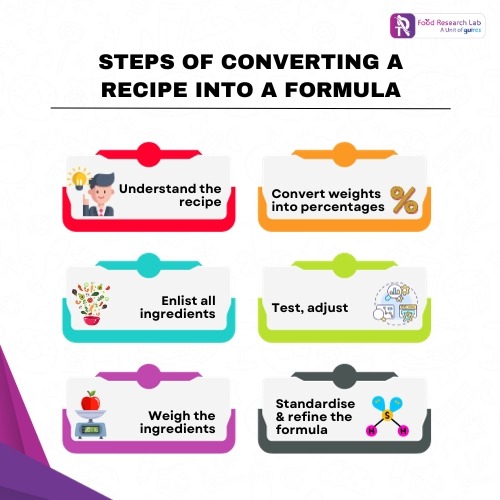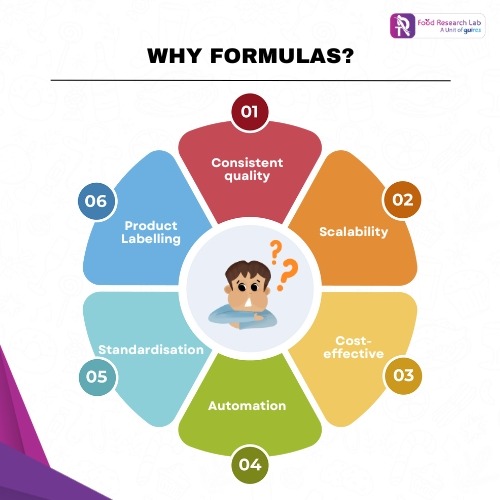How and Why to convert a food product recipe to a formula
Turning Recipes into formula process is not unlike creating a new recipe and transforming it into a formula. It all begins with a clear vision of the desired finished product (custom food solutions) and a table laden with raw materials (learned skills, professional experience and artistic traditions). Enhance all this with some science and technology, emulsify with the high shear of passion and voila! In manufacturing facilities, formulas, not recipes, are used to develop products. We at Food Research Lab employ a unique asset to create formulas: a chef-based research and development approach. We feel that our strategy has a distinct and positive impact on the development process’s outcome.
So how exactly are recipes and formulas different?
A recipe is made at home, using cups, tablespoons and pinches. However, a formula uses precise weights of the ingredients for developing a product, like grams, kilograms and pounds. These weights are subsequently converted into percentages, so that the food and beverage manufacturers know the exact amount of every ingredient that goes into developing the product.
How to convert a recipe into a formula?
Converting a recipe into a formula is a systematic process and involves the following steps:

- Understand the recipe
As a first step, understand what goes into making a product: the ingredients, their quantities and the steps involved in formulating it.
- Enlist the ingredients
List all the ingredients that go into developing the product. Also, categorise the ingredients based on the form, such as fresh, canned or frozen. If needed, also include the brand name of the ingredient. Ensure that all ingredients are included for formulating the product. A Certificate of Analysis (CoA) offers detailed information about ingredient quality and specifications and plays an important role in new product development.
- List each ingredient’s unit of measurement in weight
The next step involves listing the measure of each ingredient in weight. The ingredients in a recipe are measured by volume (i.e. cups or tablespoons) used for preparing the dish at home. These should be measured in weight before proceeding any further.
The following is an example of a recipe converted to weights for formulating a butter biscuit
| Typical butter biscuit recipe ingredients | Ingredients converted to weights |
| 3 cups whole wheat flour | 425 grams whole wheat flour |
| 1 cup water | 240 milliliters water, can be considered as 240 grams water |
| 1.5 teaspoon baking soda | 7.2 grams baking soda |
| 1.5 teaspoon salt | 9 grams salt |
| 1.5 cups butter (3 sticks butter) | 360 grams butter |
| 1 cup granulated sugar | 200 grams granulated sugar |
| 1 cup brown sugar | 220 grams brown sugar |
| 1.5 teaspoons vanilla extract | 6 grams vanilla extract |
- Convert the weight into percentage
In this step, one can add the measure of each ingredient and divide the measure by the total weight.
| Ingredient | Measure in grams | Percentage in grams |
| Whole wheat flour | 425 | 28.97% |
| Water | 240 | 16.36% |
| Baking soda | 7.2 | 0.49% |
| Salt | 9 | 0.61% |
| Butter | 360 | 24.53% |
| Granulated sugar | 200 | 13.64% |
| Brown sugar | 220 | 15% |
| Vanilla extract | 6 | 0.4% |
| Total weight | 1,467.2 | 100% |
- Test and Adjust
Use the formula to make a small test batch. The cookies are prepared by combining the ingredients, cooling them, cutting them into prerequisite shapes and baking them. They are then tasted and adjusted for flavour, texture, and consistency as desired. Make any necessary changes and adjust the formula accordingly. At this stage, the cost of preparing the biscuits is also calculated, which may depend on the ingredients.
- Record and Standardise the formula
When you are satisfied with the formula, write it down properly for future reference. Include any particular directions, measurements, and steps.
- Refine the formula
Test the formula several times to ensure consistency in results of food product development. Testing out a formula takes several trials and errors before perfecting it and proceeding with new product development.
- Consider shelf life and preservation
For commercial purposes, consider how shelf life and preservation methods (like preservative, packaging) may need to be integrated into your formula.
Why should a recipe be converted into a formula?
Formula is more beneficial than a recipe for manufacturers for the following reasons:

A. Consistent quality
Using the weight of the ingredients instead of the measures brings consistency in the finished product. Discrepancy may arise in measurements from one person to another. One cup of flour for one person may not be the same for another- some may take heaped measurements, while some may take levelled measurements.
B. Formulas facilitate scalability
Formulas allow adjustment in quantities, allowing for greater flexibility in scaling up or down per the requirements. Formulas ensure that there is no compromise in the integrity of the product.
C. More cost-effective
Weighing the ingredients gives a better control over the cost of developing a product. Manufacturers can understand the unit costs, the Cost of Goods Sold (COGS) and the product margins.
D. Facilitates automation
In a world where food processing is automated, formulas are preferred over recipes. Processors can be programmed to follow formulas, and this can lead to increased efficiency and reduced errors.
E. Standardisation
Formulas assist in industry standardisation by giving a standardised set of instructions that can be followed consistently. This is critical for guaranteeing product quality and compliance with international regulatory standards.
F. Helps with product labelling
Consistency in the quantity of ingredients used will ensure a more uniform product labelling in relation to its nutritional value and label information.
Conclusion
While the term ‘recipe’ and ‘formula’ are used interchangeably, the term ‘recipe’ is used for cooking and ‘formula’ is used when a product is developed in larger quantities. For converting a recipe into a formula, one must first convert the measures into weights and subsequently, percentages. Then, they must test and refine the formula for quality. Formulas help in maintaining consistent quality, facilitate scalability, are more cost-effective and help with automation, standardisation and product labelling, which are crucial for the proper functioning of a manufacturer.
How Food Research Lab Global Contract R&D can help
At Food Research Lab, we offer formulation development and scale-up services for a wide range of products like food, beverage, nutraceuticals, pet food, cosmeceuticals and herbal products. We help with developing a new product, reformulating an existing product by reverse engineering or with line extension of the product. We understand that consistency in ingredient quantity is quintessential in the success of a product and hence help manufacturers with developing suitable formulas for the products, which facilitates automation, brings consistency in product quality and are more cost-effective in the long run, guaranteeing their success in the long run.

Let’s create something Innovative and Delicious together
Food Research Lab strives for excellence in new Food, Beverage and Nutraceutical Product Research and Development by offering cutting edge scientific analysis and expertise.




